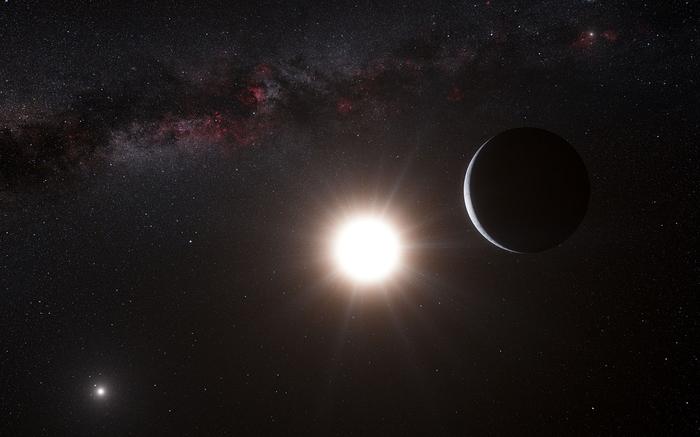Alpha Centauri Has a Planet
European astronomers have discovered a planet with about the mass of the Earth orbiting a star in the Alpha Centauri system — the nearest to Earth. It is also the lightest exoplanet ever discovered around a star like the Sun. The planet was detected using the HARPS instrument on the 3.6-metre telescope at ESO’s La Silla Observatory in Chile. The results will appear online in the journal Nature on 17 October 2012.
This is incredibly exciting to me! A few years ago, when I worked on Hubble, I looked into using it to search for planets around Alpha Cen. I worked out some simulations to see if we could detect anything, and at best we could see a Jupiter-sized planet orbiting far enough out that its faint light wouldn’t be blasted out by the star itself. It was deemed too risky an observation (too low a chance of payoff) so we didn’t get time on the telescope to make it. We’d never have seen this planet anyway; looking for a planet reflecting its star’s light is very different than looking for the Doppler shift. Obviously!
Also, c’mon. This is Alpha Centauri! Famed and fabled in a thousand science fiction stories. It’s where the Robinson family was supposed to go in “Lost in Space”. It’s where Zefram Cochrane lived in “Star Trek”. It’s where the Fithp came from in Footfall. Because the system is bright and close, and the stars so close to being like our own Sun, they’re an obvious place to put aliens. Plus, you get the exotic locale of a binary star plus the red dwarf thrown in on top. It’s perfect!
So I, and a lot of people like me, grew up hoping against hope we’d find a planet around one of these stars someday.
And here we are.
— Phil Plait (Bad Astronomer)
via ESO and Bad Astronomer
Neil deGrasse Tyson Ponders About Life On Europa
“There are no fish and no kids?”
A Pale Blue Self-Portrait
Aki Hoshide, a Japanese astronaut, has taken a picture of himself during a spacewalk around the International Space Station:
via NASA
Smooth Video of Curiosity's Descent
Bard Canning has made this motion-flow interpolated video using the original images taken by the Curiosity rover as it descended to the surface of Mars:
Very cool.
via reddit
M7 in Scorpius
Are those grains of sand, or are they stars?
Incredible.
From NASA APOD:
M7 is one of the most prominent open clusters of stars on the sky. The cluster, dominated by bright blue stars, can be seen with the naked eye in a dark sky in the tail of the constellation of the Scorpion (Scorpius). M7 contains about 100 stars in total, is about 200 million years old, spans 25 light-years across, and lies about 1000 light-years away. The above deep exposure was taken from Hakos Farm in Namibia. The M7 star cluster has been known since ancient times, being noted by Ptolemy in the year 130 AD. Also visible are a dark dust cloud and literally millions of unrelated stars towards the Galactic center.


